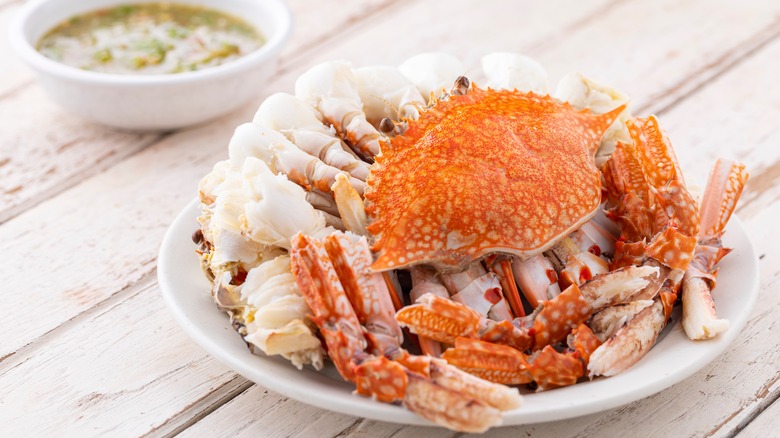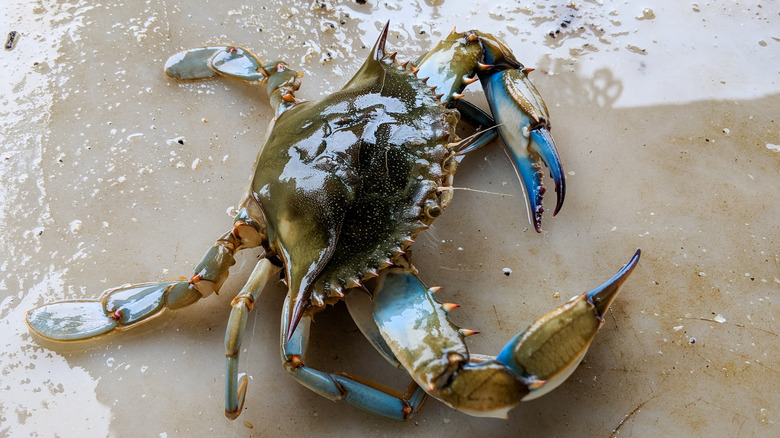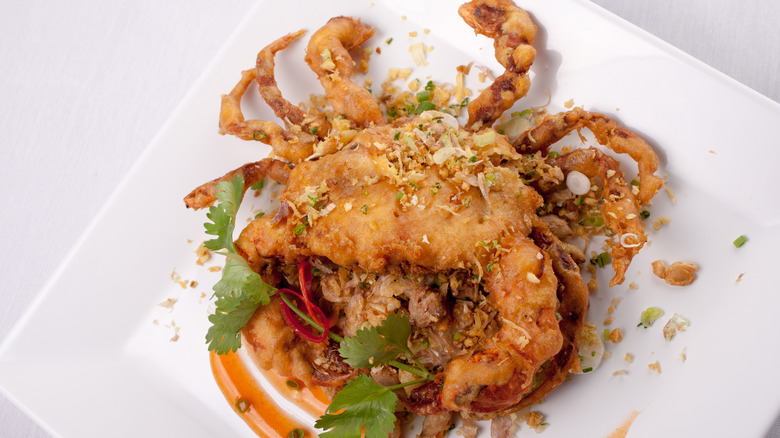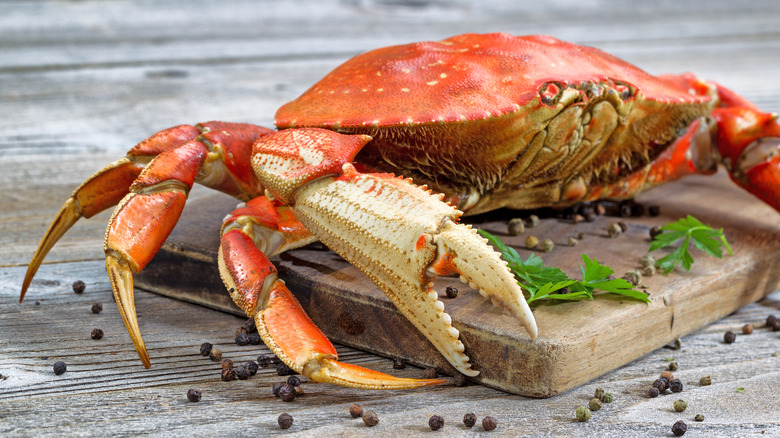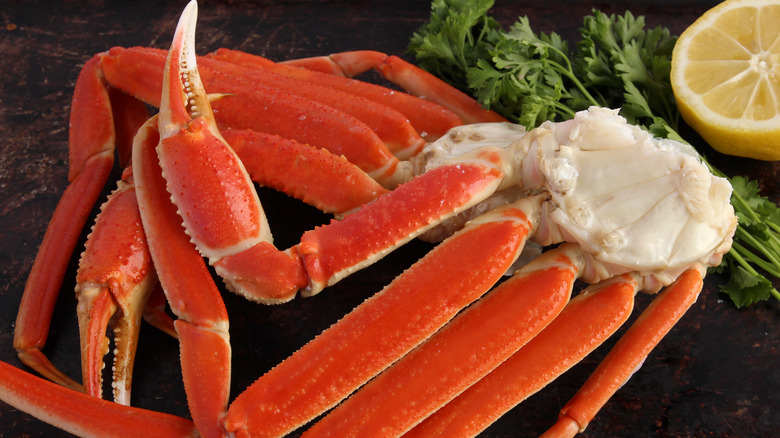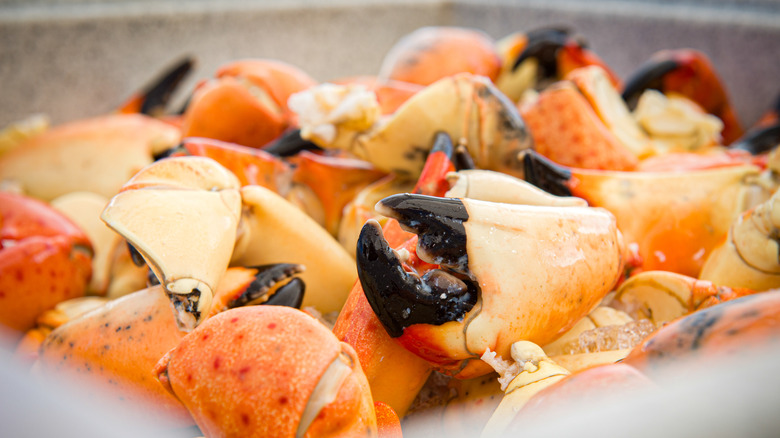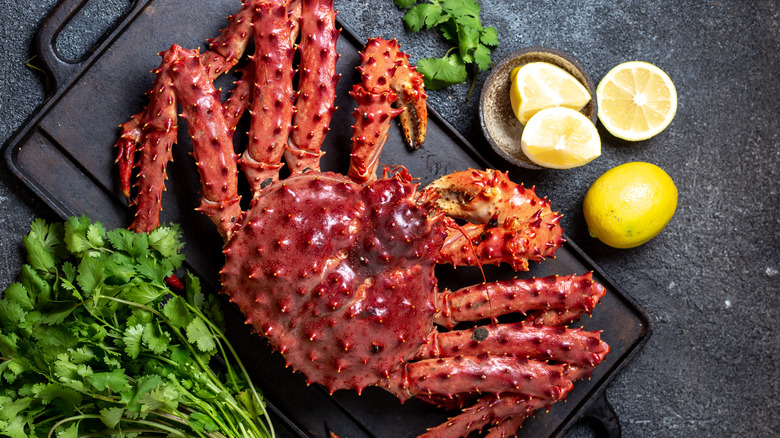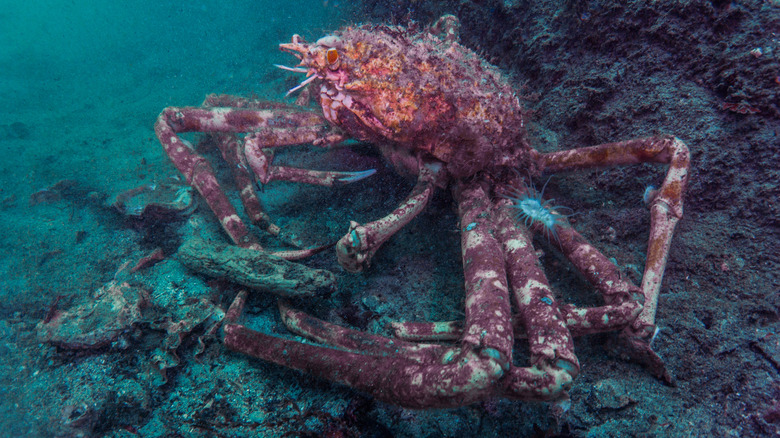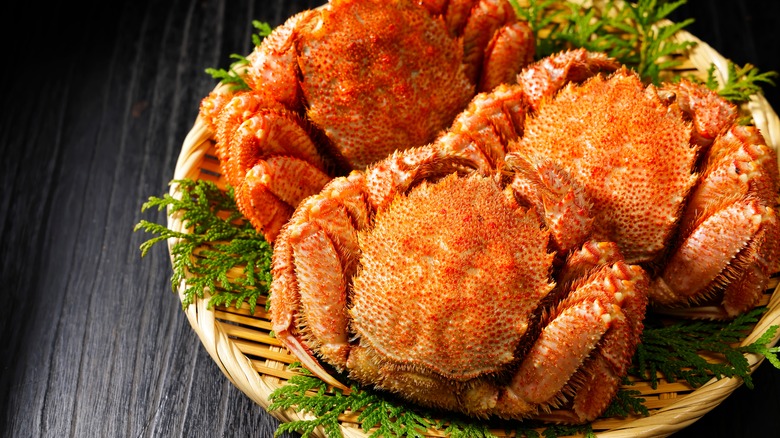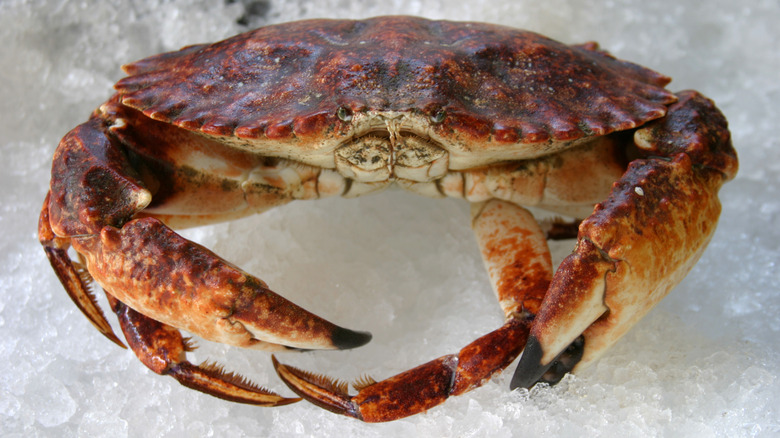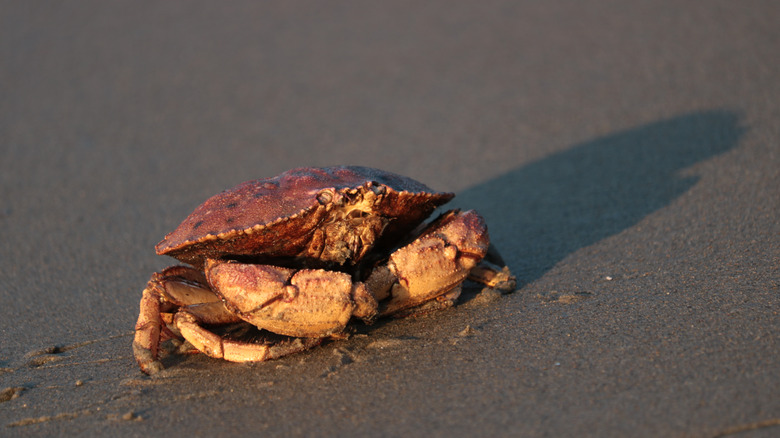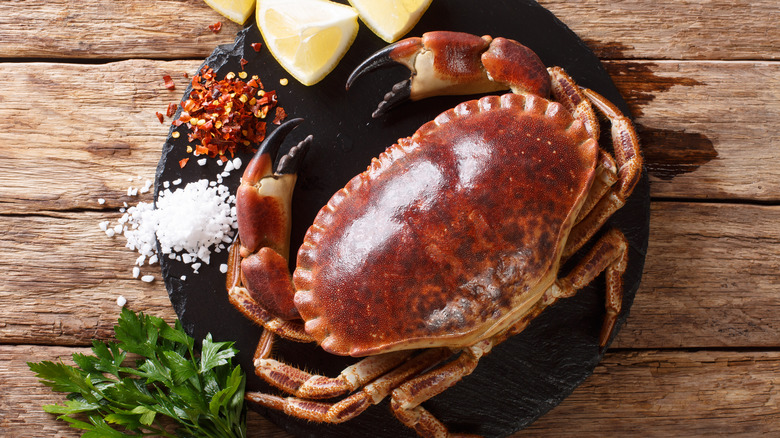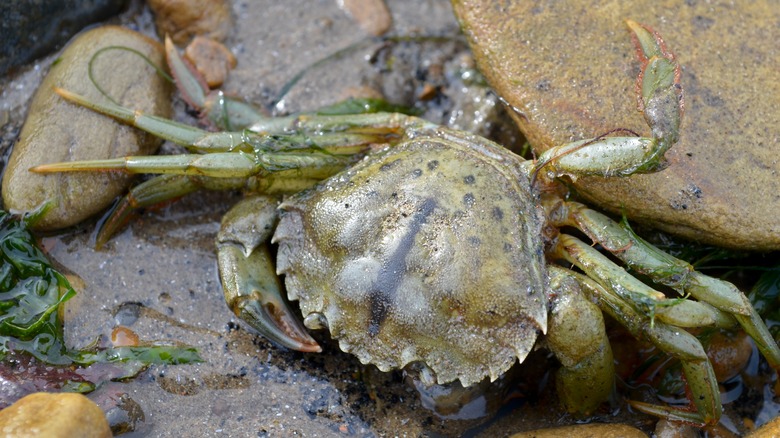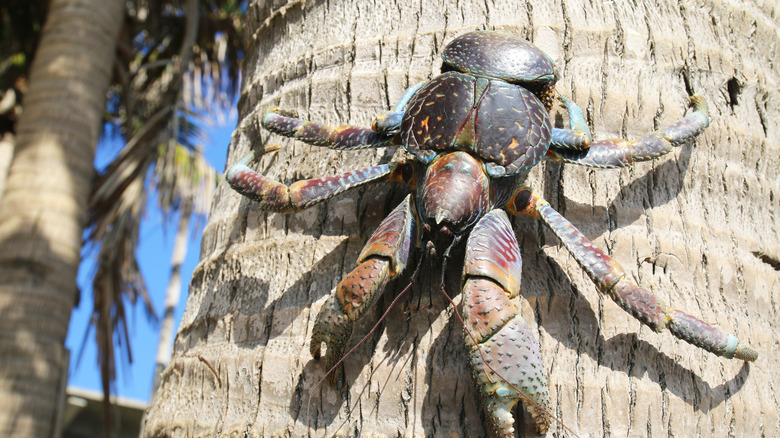The Most Delicious Types Of Crabs To Eat
Crabs have long been a popular, albeit an expensive, seafood delicacy for folks worldwide and for all the right reasons. Besides being incredibly versatile on the cooking part, the delicate and juicy meat tastes simply sublime. However, that's not even the best part about these crustaceans. As per New World Encyclopedia, there are nearly 4,500 crab species from all over the world. And that's only the number known to us; there are plenty more out there waiting to be discovered.
While you may consider it futile, knowing a bit more of your crab options can literally make the difference between a rubbery, bland crab cake and a deliciously sweet, plump one. In this article, we cut through the noise and discuss the most delicious types of crabs to eat and assorted tips on how to prepare each popular crustacean.
Maryland Blue Crab
The warm waters of Maryland are full of blue crabs, which are, hands down, one of the most delicious types of crabs available today. Blue crab, whose scientific name, Callinectes sapidus, literally translates as "Savory Beautiful Swimmer," aren't entirely blue, though. ThoughtCo describes them as greyish-bodied crustaceans with an enchanting blue pigment illuminating the legs and claws. However, once cooked, these blue beauties turn a gorgeous shade of red (via CrabbingHub).
On the taste part, unlike most crab varieties, these have a noticeably meatier feel coupled with brinier notes to give a rather wild and nutty touch. However, they still have a subtle sweetness to balance the overall flavor. These epic crustaceans usually dwell on the eastern coasts of the United States, primarily found near Maryland, hence the name. As per the Maryland Manual On-Line, "The Chesapeake Bay, Maryland" is responsible for almost half of the total blue crab population in the United States.
When it comes to cooking these blue beauties, the possibilities are virtually endless. You can enjoy them in the form of a perfectly sautéed crab cake or a creamy crab dip. You can also eat freshly cooked blue crab meat the Tim Marose, aka the "Crab Eater" way, straight out of the shell with Old Bay seasoning and a cold beverage.
Soft-Shell Crab
Next up on our list of the most delicious types of crabs to eat is soft-shell crab. Keeping true to their name, soft-shell crabs are often called "softies" by crab enthusiasts, given their no-shell state. The softies are basically blue crabs that have recently molted their shells, resulting in a marble-like thin shell with translucent spots. They are harvested before the new shell hardens (via Seriouseats).
As per the National Geographic's Future of Food series, blue crabs are specially harvested in the warmer months of the summer season when they shed their hard shells so they can grow larger. The transformed crabs have a softer body, and their entire body is up for grabs — claws, legs, shells, and everything else.
Usually eaten whole, the soft bodies can be consumed in multiple ways except boiled, as without a hard shell their outer bodies tend to crumble in hot water. Chef Jaime Young of a famous NYC restaurant, Sunday in Brooklyn, recommends eating these delicate beauties fried, "brushed with black garlic and topped with pumpkin seeds."
Dungeness Crab
Soft, sweet, juicy, with just the right amount of flakiness, the Dungeness crab is yet another prized crustacean worthy of your attention. While you'll see their hype build throughout the entire year, they are usually available for feasting during the fall and spring.
Unlike our top two delicious picks, the Dungeness crab rules the northern shores of the United States, mainly lurking on the nearshore coast and estuaries of Alaska. Surprisingly they are also found in the far south of Mexico, the Magdalena Bay (via Alaska Department of Fish and Game). The Washington Department of Fish and Wildlife notes that Dungeness crabs are purple-hued paired with white-tipped claws, making for a pretty color combination.
When it comes to eating Dungeness crab, as per Chef Chester Gerl of Seattle waterfront restaurant Gracia, the best way to fully appreciate it is by preparing a delectable crab Gazpacho. There are several other methods of eating Dungeness, as Tasting Table notes, depending on how simple you want to keep it or how creative you want to be.
Snow Crab
Snow crab, as evident by the name, dwells in the icy cold waters of the North Pacific Oceans and North Atlantic. Interestingly, that's not where snow crabs earned their name from. The inspiration behind their name is actually the magnificent meat, which turns from red to white once cooked (via AZ Animals).
As per Oceanside Seafood, snow crabs crawl the Alaskan shores with four pairs of legs, which are one of the most accessible snap-and-eat crab legs to enjoy. From oven broiling to steaming, grilling, and boiling, you can prepare crab legs in multiple ways. While snow crab meat is sweet and comparatively milder than king crab, it is, however, equally tasty and tender.
Courtesy of their thin shells, the legs of snow crabs can be easily cracked open with your hands. So keep aside all tools, snap a leg, and munch on the delicious snow-white meat with a dash of squeezed lemon or dipped in drawn butter. You can also not go wrong with making instant pot crab legs and enjoying them with a side of Gruyère scalloped potatoes.
Florida Stone Crab
After a quick cold-water detour, we return to our warm-water crustaceans. Plentiful along Florida's Gulf Coast, Florida stone crab is one of the most unique and sought-after seafood delicacies. Stone crabs are known for their dense but delicate claw meat, sweet and briny. Covering the crustacean's meat is a shiny red-colored shell and a pair of similarly toned claws (via Visit Florida).
Business Insider notes that due to the great demand for the Florida stone crab claws, harvesters skillfully detach one claw from the rest of the body, then throw the crabs back into the water where they grow a new claw. Since the process is incredibly arduous, the claws of stone crabs are one of the most expensive seafood items. What's more, the claws are boiled by fishermen immediately after their removal so that the meat doesn't stick to the shell, according to the Florida Department of Agriculture and Consumer Services, so by the time they make it to market, they are already cooked and ready to be eaten. Of course, if you want them hot, just throw them in boiling water or a steamer basket for a few minutes prior to cracking the shells, which is done by whacking them with a mallet because they are so hard. Cold stone crab claws are traditionally served with a mustard-based dipping sauce, and hot claws get drawn butter, naturally.
King Crab
Make way for the king of kings in the crab realm, the cold-water crustacean, king crab. Given the gigantic size, dark burgundy red body (after cooked), and extraordinarily delicate and sweet meat, the king crab has a large fan following. Brown to bluish red prior to being cooked, these mighty giant crabs dwell in areas in the Bering Sea, including Norton Sound, Bristol Bay, the Western Aleutian Islands, and the Pribilof Islands, according to NOAA Fisheries. They also hang out on the Gulf coast of Alaska.
Regarding tastiness, king crabs stand true to their title. Like most cold water crab species, the king crab's shell hides red-hued tender meat that turns white once cooked. And as with most crabs, the fresher the crab, the better the flavor profile and texture you will experience. If you are a die-hard crab enthusiast, fly to the nearest king crab habitat, just like Gordan Ramsey did, and catch, kill and cook one all by yourself.
While that option may not be available to everyone, imported king crab is still delicious. The best part about eating it is that king crab already holds a great deal of flavor, so you will hardly need to couple it with something else. However, mayonnaise-based sauces go pretty well with a warm, freshly-cooked king crab.
Japanese Spider Crab
Not exactly a spider, but not quite all crab either; the Japanese spider crab looks straight out of a sci-fi thriller. Don't be alarmed, though. These giant creatures are actually pretty gentle and, more importantly, deliciously edible.
Quite surprisingly, this spider-like crab even beats the king crab in terms of size, with the largest leg span found in any other arthropod crustacean. As noted by Monterey Bay Aquarium, a Japanese spider crab's body can grow to about a foot wide while the legs can extend up to 12 feet to 12.5 feet from claw to claw.
As per National Geographic, the Japanese spider crab stretches from the Pacific side of Japan and extends south to Taiwan. These giant sea creatures are scientifically known as Macrocheira kaempferi, but they are called takaashigani by the locals in Japan, which loosely translates to "long-legged crab."
Though very strange in appearance, Japanese spider crab tastes just as brilliant as your usual crabs. As Japan Truly notes, preparing this beast is no child's play. And this is precisely why you won't see Japanese spider crabs on your local restaurant menus. Cooking them requires an extra-large boiling container. As the pot comes to a rolling boil, you simply slide the Japanese spider crab inside, and in just about 20 minutes, it will be ready. However, since Japanese spider crabs are a potentially endangered species, Japan has prohibited their fishing during their spring breeding season, per Japan Travel.
Horsehair Crab
Another crab species closely tied with the Japanese dining culture, this cute little fellow is an absolute seafood delight enclosed in a petite soft-shell body covered with tiny hairs. Also known as Kegani, these little beauties are primarily located in the Northwest Pacific, around the Hokkaido coast in the Sea of Okhotsk and the Western Bering Sea (via Live Japan).
Though the hairy appearance is the leading cause of its attraction, the horsehair crab's dense, sweet taste is unparalleled. The compact body sets forth firm-textured meat, unlike usual crabs. To get the freshest horsehair crab stock, try getting them in the spring season. During this period, large numbers of horsehair crabs unveil themselves on the shores of Okhotsk around Hokkaido. However, a bunch might still be spotted lurking around Hokkaido's coast during any season, which is why its price stays relatively the same throughout the year.
As Bow Tie Duck notes, the best way to fully appreciate a horsehair crab is by boiling the crustacean in salted water. Once cooked, you can eat it simply boiled, or if you prefer a slight creaminess, brushing them with nori butter works really well.
Rock Crab
Keeping true to their name, rock crabs possess shockingly hard outer shells, so much so that if it weren't for the shell's color, the crabs would literally look like crawling rocks. Rock crabs have a pretty extensive range that expands along the West coast of North America from Alaska to Mexico (via Central Coast Biodiversity).
As per AZ Animals, rock crabs are primarily three colors: red, yellow, and brown. The color is determined by the crab's location, as yellow crabs are found mainly in sandy areas along the coast, and red crabs are usually plentiful on the Pacific Coast. Brown rock crabs typically dwell on reefs. Given the massive load on their back, rock crabs are generally smaller.
Taste-wise, inhabitants of the Western U.S. coasts, especially Californians, would know what the fuss is about. Rock crabs offer an exceptionally balanced taste and brininess like no other. The best representatives of this claim, however, are only the crustacean's legs and the catcher claws, as the rest of the body is relatively small to provide any substantial meat. Monterey Bay Fisheries Trust reminds folks to be wary of this crustacean's painful pinch, though. These suckers don't let go without putting up a fight.
The best way to reap the most out of rock crab's claws is steaming them up and topping them with Old Bay seasoning for a sublime flavor. For an even more exceptional experience, serve the claws with drawn butter or grill them to extract a slightly smoky taste.
Peekytoe Crab
Another interestingly named crab, peekytoe crab (an abbreviated form of "picked toe" and pronounced as pick-et toe), is also known as Atlantic rock crab. Initially prevalent in Penobscot Bay in Down East Maine, peekytoe crabs are now sourced from Rhode Island to Nova Scotia, according to the Spruce Eats.
This poor guy was once considered just a useless byproduct of lobster catching until it became one of the most in-demand crustaceans for chefs worldwide. The "handpicked leg and toe meat," which comes from rock crabs, is snow-white with a subtle pinkish hue. It's pretty firm but also delicate and silky simultaneously. However, the vital thing you need to know is that these beauties are delicious, moderately sugary, tender in texture, and slightly salty, just enough to suit everyone's taste buds (via Browne Trading).
Because of its versatility, there are lots of preparation styles for peekytoe crab that employ regional cooking techniques and flavors, as per the Maine Seafood Guide. Since they are cooked and handpicked right after they're pulled onto boats, the meat is used in crab cakes, rolls, or side dishes like salads and dips. If you get your hands on a live peekytoe, you can steam, broil, grill, or roast it. Residents of Maine can better employ the potential hiding inside Peekytoe Crabs as these buddies are best consumed immediately after being caught.
Brown Edible Crab
If you have ever toured the northeastern arm of the Atlantic Ocean or the landlocked Mediterranean and love seafood, chances are you've encountered a sturdy crab with black-tipped claws and a red brick shell that's hard but not as rock crab's, aka a brown edible crab. Typically known as the edible crabs, brown crabs, or Cancer Pagurus, these brown beauties are plentiful in Norway all the way through the North Sea and the English Channel to the coast of Portugal (via MarLIN).
The meat is sweet, soft, and delicate, similar to most crab meat. The unique selling point of brown edible crabs is that they are dual-colored, meaning the crab's legs and claws are white, whereas the rest of the crustacean has brown meat. This results in an incredibly versatile range of flavors. Sounds amazing, right?
However, Dr. Alison Halliday notes that there have been some concerns about the levels of a toxic metal, cadmium, in the brown meat. So, it's best to focus on this crustacean's legs and claws and limit your brown meat consumption.
As per Klaw, the best way to fully appreciate brown edible crab's meat is the claws pulled off and the top shell and the lower body separated. The crab's hills on the lower body, also known as "dead man's fingers," are also removed. Next, the body and claws are cracked open to access the soft, delicate, and sweet meat. Sprinkle your crab meat with a generous dose of Old Bay seasoning for a unique flavor profile.
Southern European Crab
Closely tied to the European dining culture, Southern European crab (which also goes by shore crab or green shore crab) has a fascinating history. While this European delight is an edible freshwater crustacean that mainly dwells in the Rivers of Italy and Greece, the past few years have shown plenty of them invading the western Canadian coast (via Government of Canada).
While this was definitely good news for seafood lovers, the invasion did more bad than good. It harmed the population of other crab species, including the Dungeness. To mitigate the increasing colonization by the European crabs, lead researcher Shon Schooler proposed a rather unusual but practical way out — catch and eat them — per NPR.
However, that's not the only reason you should be feasting on these green beauties. With an extraordinarily succulent texture and a rich, delicate flavor that is an excellent blend of tanginess and umami undertones, Southern European crabs sell themselves. You can have them fried or boiled and eat them as a whole — legs, claws, innards, and everything else. Since this also eliminates the tedious process of picking the meat out of limbs, as with most crab varieties, Southern European crabs are usually favored by chefs and diners.
For something new, try molted green crabs, typically served as moeche on European restaurant menus, as per Enrica Rocca, a celebrity chef in Venice (via Down East). Moesche is prepared by marinating soft-shell crab in an egg batter for a few hours, dusting with flour, and deep-frying.
Coconut Crab
A crustacean with many names, the coconut crab (also known as robber crab, palm thief, and terrestrial hermit crab) is native to islands of the central Pacific Ocean and the Indian Ocean. While no threat to humans, animals and plants aren't that lucky. Courtesy of their strong pincers, they can pick apart almost anything, from coconuts to birds to kittens and pig carcasses (via ATI) — those things are all options because this crab lives on land and only goes into the ocean once a year to lay eggs, per JSTOR Daily.
Folks who have seen a coconut crab will know it's no ordinary shellfish. These giant terrestrial arthropods can grow up to 3.3 feet long while weighing around 9 pounds. As Jstor Daily notes, these crabs are even known to take manmade items (hence the name, robber crabs) including wrist watches, pots, pans, and whiskey bottles.
Coconut crabs are listed as a potentially endangered species on the IUCN Red List. And that's why hunting for egg-bearing female coconut crabs is prohibited in Guam and Micronesia. Furthermore, there's a limit to the total number of coconut crabs you can capture daily or in a year, but if you have the opportunity to prepare and eat one, according to Robert Arrington, of the YouTube channel Deer Meat For Dinner, simmering it salted water is the best way to cook a coconut crab.
